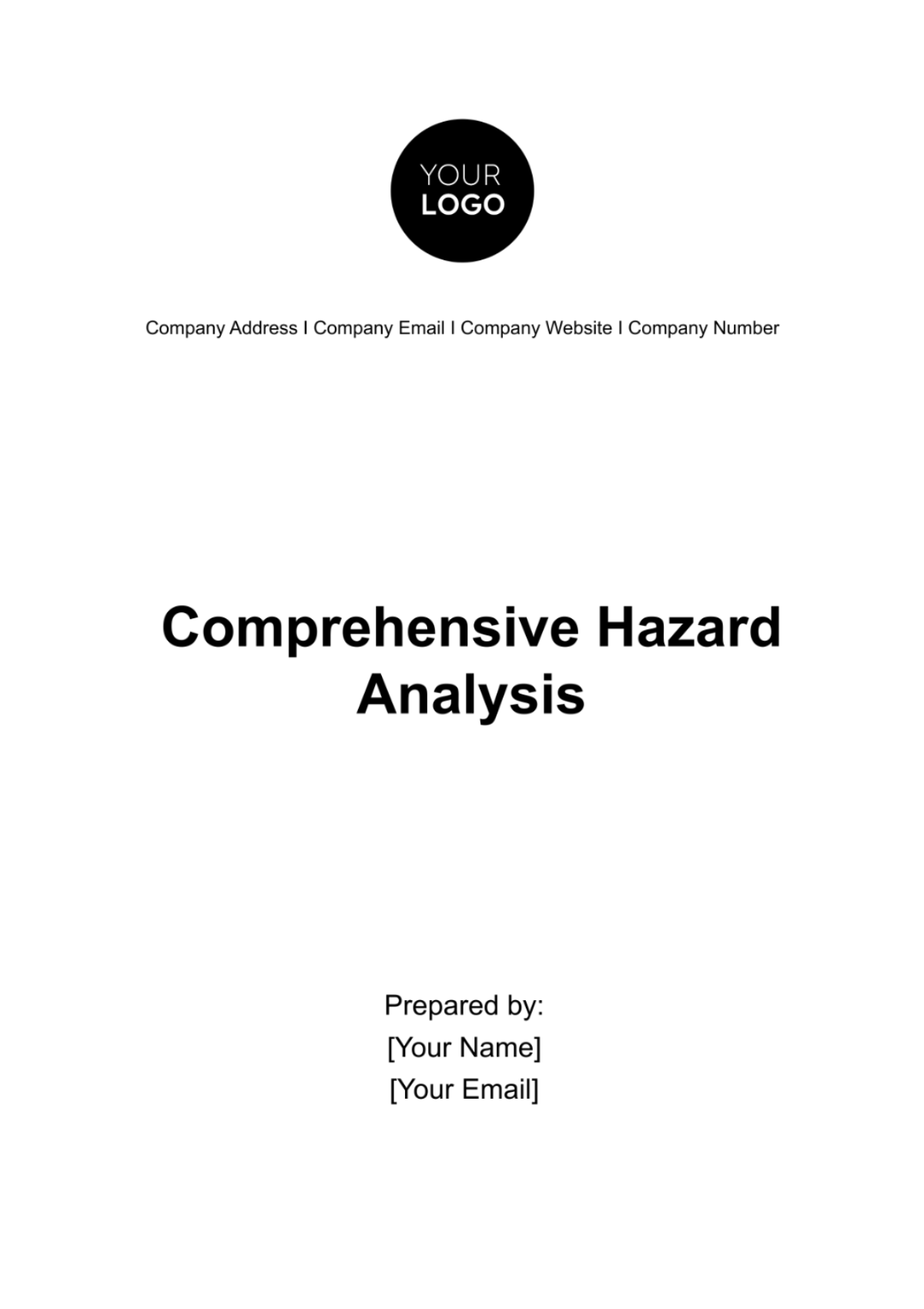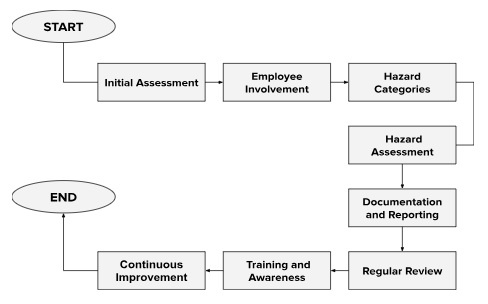Free Comprehensive Hazard Analysis

A. Introduction
Welcome to the [Your Company Name] Comprehensive Hazard Analysis. Our commitment to safety is paramount, and this manual is designed to ensure the health and well-being of all employees. Safety is not just a priority; it's a core value that guides our operations.
In compliance with US health and safety standards, this Comprehensive Hazard Analysis provides essential guidelines, procedures, and best practices to maintain a safe and healthy workplace. It is crucial that all employees, from management to staff, understand and follow these safety protocols to create a secure working environment for everyone.
B. Scope and Objectives
1. Scope
The scope of this Workplace Detailed Safety Manual encompasses all aspects of safety within [Your Company Name]. It applies to all employees, contractors, and visitors on our premises. It covers a wide range of potential hazards and risks associated with our operations, from physical safety to health and environmental concerns. This manual also outlines the responsibilities of each stakeholder in ensuring a safe workplace.
2. Objectives
a. Injury Prevention: The primary objective of this manual is to prevent workplace injuries and accidents. By implementing the guidelines and procedures outlined herein, we aim to minimize the risk of injuries to our employees and visitors.
b. Compliance: We strive to ensure full compliance with US health and safety laws and regulations. This manual serves as a tool to maintain legal compliance and adhere to industry standards, protecting our company from potential liabilities.
c. Continuous Improvement: Our objective is not only to meet safety standards but to exceed them. We are committed to fostering a culture of continuous improvement in safety practices, which includes ongoing training, hazard identification, and the implementation of best practices.
3. Regulatory Compliance
At [Your Company Name], we are dedicated to adhering to all relevant US health and safety regulations and standards. Ensuring regulatory compliance is not just a legal obligation but a fundamental aspect of our commitment to safeguarding the well-being of our employees and stakeholders. This section provides an overview of the key regulatory frameworks that guide our safety practices.
Regulatory Compliance |
OSHA Compliance |
The Occupational Safety and Health Administration (OSHA) sets the foundation for workplace safety in the United States. We strictly comply with OSHA regulations, which cover a wide range of safety aspects, including hazard communication, personal protective equipment (PPE), machine guarding, and more. Our commitment to OSHA compliance is unwavering, and we regularly review our practices to ensure alignment with the latest OSHA standards. |
Environmental Regulations |
In addition to workplace safety, we also adhere to environmental regulations that impact our operations. Compliance with regulations such as the Clean Air Act, Clean Water Act, and Resource Conservation and Recovery Act (RCRA) is vital to minimizing our environmental footprint and protecting the communities in which we operate. |
Industry-Specific Standards |
Depending on your specific industry, there may be additional standards and regulations that apply. We recognize the importance of industry-specific standards and ensure that our safety practices meet or exceed these requirements. Whether it's the healthcare industry, construction, manufacturing, or any other sector, we tailor our safety measures accordingly. |
D. Hazard Identification
Introducing our comprehensive Hazard Identification Steps guide. This essential tool enables organizations to systematically identify and mitigate workplace hazards. With clear, actionable steps, employees can actively participate in hazard identification, fostering a culture of safety and continuous improvement. Protect your workforce with this vital resource.

E. Risk Assessment
Risk assessment is a critical component of our commitment to workplace safety at [Your Company Name]. It involves a systematic evaluation of identified hazards to determine the potential risks they pose. This process aligns with US health and safety standards and helps us prioritize and implement effective control measures.
Methodical Evaluation: Our risk assessment process follows a methodical approach. We consider factors such as the severity of potential harm, the likelihood of occurrence, and the consequences of each hazard.
Risk Prioritization: After assessing hazards, we prioritize them based on their risk level. High-risk hazards are addressed with urgency, while lower-risk ones receive appropriate attention.
Data-Driven Decision-Making: Our assessments are data-driven, allowing us to make informed decisions. We use risk matrices and analysis tools to quantify and qualify risks accurately.
Continuous Improvement: We view risk assessment as an ongoing process. As our workplace evolves, so do our assessments. Regular reviews and updates ensure our safety protocols remain effective.
F. Risk Control Measures
Safety at [Your Company Name] is paramount. Our Risk Control Measures, aligned with US health and safety standards, are a crucial aspect of our commitment. This concise list outlines various approaches, from engineering controls to safe work practices, aimed at minimizing workplace hazards. Implementing these measures is integral to fostering a safety-first culture and ensuring the well-being of all.
Engineering Controls: Implement physical changes to eliminate or reduce hazards. Examples include machine guards, ventilation systems, and ergonomic equipment.
Administrative Controls
Personal Protective Equipment (PPE
Substitution
Isolation
Safe Work Practices
Training and Education
Emergency Preparedness
Monitoring and Inspection
Safety Culture
G. Emergency Response Plan
Our Emergency Response Plan (ERP) at [Your Company Name] is a meticulously crafted framework designed to ensure a swift and effective response to critical situations. This section outlines our eight-step ERP, aligned with US health and safety standards. Each step is carefully detailed to guide employees, contractors, and visitors in the event of emergencies, reinforcing our commitment to their safety and well-being.
Step 1: Emergency Recognition
Recognize the nature and scope of the emergency.
Activate alarms and alert systems as necessary.
Step 2: Immediate Response
Evacuate the area if it's safe to do so.
Ensure everyone is accounted for, and assist those with special needs.
Step 3: Alert Authorities
Dial emergency services (911) to report the situation.
Provide essential information, including location and nature of the emergency.
Step 4: Internal Notification
Alert all employees and visitors of the emergency.
Provide clear instructions on actions to take, such as evacuating or seeking shelter.
Step 5: Emergency Services Coordination
Designate a responsible person to liaise with emergency services.
Provide real-time updates and guidance to responders.
Step 6: Evacuation and Sheltering
If evacuation is required, follow pre-established evacuation routes and assembly points.
For certain emergencies (e.g., severe weather), instruct individuals to seek shelter in designated areas.
Step 7: Medical Assistance
Administer first aid to injured individuals, if trained and safe to do so.
Await the arrival of professional medical assistance for more severe injuries.
Step 8: Post-Emergency Assessment
Conduct a thorough assessment of the emergency response.
Identify areas for improvement and update the ERP as necessary.
H. Monitoring and Inspection
Monitoring and inspection are proactive measures we employ to ensure the ongoing effectiveness of our safety protocols. These processes help us identify potential hazards, assess compliance with safety procedures, and take corrective actions as necessary.
Regular safety audits, equipment inspections, and training program reviews are part of our routine. Incident analysis allows us to learn from past events, and emergency drill evaluations ensure we are well-prepared for unforeseen situations.
Through these ongoing efforts, we maintain a safety culture where monitoring and inspection contribute to preventing hazards, ensuring regulatory compliance, and continuously improving workplace safety.
Documentation and Record-Keeping
Documentation and Record-Keeping are essential pillars of our safety program at [Your Company Name]. In this section, we emphasize the significance of maintaining accurate records to ensure compliance with US health and safety standards. The following list outlines the guide to our documentation and record-keeping practices:
Incident Reports: Comprehensive documentation of all workplace incidents, including near misses, injuries, and property damage.
Safety Training Records: Records of employee safety training, certifications, and ongoing education to validate competence.
Safety Policy and Procedure Archives: Centralized storage of all safety policies, procedures, and updates for easy access.
Equipment Maintenance Logs: Detailed logs of equipment inspections, maintenance, and repairs to confirm compliance with safety standards.
Regulatory Compliance Records: Records demonstrating compliance with relevant US health and safety regulations, including permits and certifications.
These collectively support our commitment to transparency, accountability, and continuous improvement in workplace safety. Proper documentation and record-keeping enable us to learn from past experiences, track progress, and ensure the safety and well-being of all stakeholders.
J. Review and Revision
Review and Revision are integral to our commitment to safety at [Your Company Name]. In this section, we emphasize the importance of continuously assessing and improving our safety protocols. Below, we present a list that guide our review and revision processes.
Periodic Safety Audits: Scheduled assessments of safety practices to identify areas for enhancement and compliance with standards.
Regulatory Updates: Regular reviews of changes in US health and safety regulations to ensure ongoing compliance.
Incident Analysis and Learning: Thorough examination of incidents and near misses to identify root causes and implement preventive measures.
Employee Feedback: Encouragement of employee input and feedback to improve safety practices.
Documentation Review: Regular evaluation of safety documentation and record-keeping to verify accuracy and completeness.
These collectively support our commitment to a dynamic safety culture where review and revision are ongoing processes.
Through continuous assessment and improvement, we enhance our ability to prevent hazards, maintain compliance, and promote the well-being of all stakeholders.
- 100% Customizable, free editor
- Access 1 Million+ Templates, photo’s & graphics
- Download or share as a template
- Click and replace photos, graphics, text, backgrounds
- Resize, crop, AI write & more
- Access advanced editor
Introducing the Comprehensive Hazard Analysis Template from Template.net. Crafted with precision, this editable and customizable template empowers you to assess and mitigate risks effectively. Seamlessly integrate your insights using our intuitive Ai Editor Tool. Elevate your safety protocols with this essential resource. Unlock peace of mind today.





























